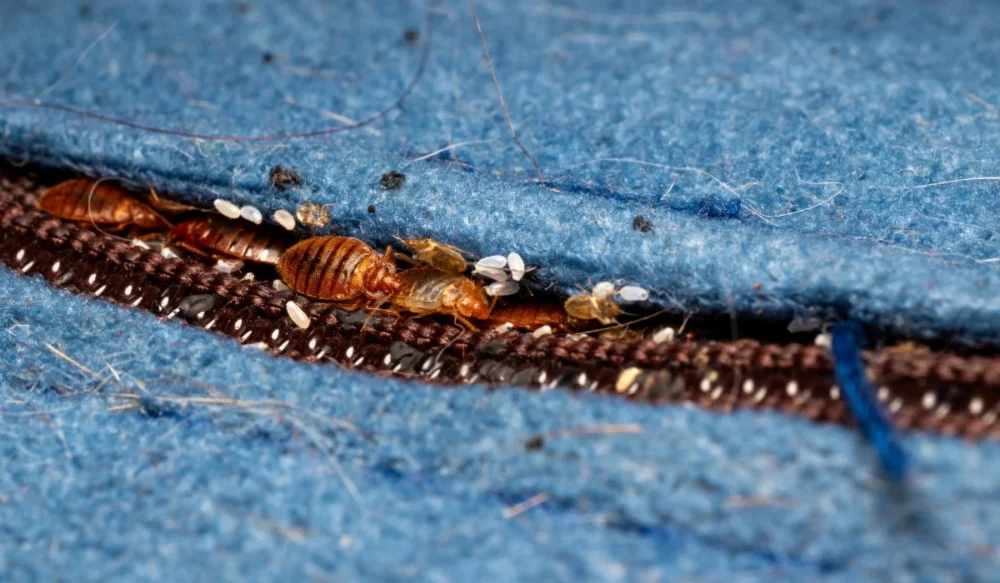Bed bugs are mysterious insects, which is one reason why Tucson residents are filled with horror when they think they have these bugs. Imaginations run wild. Where are the bugs hiding? Are they going to come out every night and bite us while we sleep? Do bed bugs spread diseases? Today, we hope to remove some of the mystery about how you get bugs and where they hide. We’ll also share some tips to help you prevent a bed bug infestation if you haven’t already gotten these bugs. As for those other fears, if you stick with us to the end, we’ll tell you how to get rid of bed bugs. If you need immediate assistance, navigate to our contact page for professional bed bug pest control in Tucson.
What Are Bed Bugs?
The simple answer to this question is that bed bugs are blood-eating insects, but as you know, nothing in life is ever simple. There are different types of bed bugs. Some prefer human blood, while others prefer animal blood.
Bat bugs are a good example of bed bugs that don’t typically lurk in beds. You could call them bed bugs because they’re similar in every way, but since they live in cracks and crevices near where bats hang out (a.k.a sleep), it doesn’t make sense to call them bed bugs. It doesn’t make sense to call them bat bugs either because they’ll feed on other animals. The way these two insects are similar is that they both establish themselves close to their source of food and they don’t prefer to feed on multiple people or animals at once. They are parasites, but they don’t live on their hosts. And, perhaps most noteworthy, bat bugs and bed bugs are both indoor insects.
Bed bugs have been indoor insects since the beginning of history. In fact, fossilized bed bugs dating thousands of years old were found in an Oregon cave. So, we can’t say bed bugs were brought here from Europe, though Europeans didn’t help matters. Many bed bugs made the trip across the Atlantic Ocean in the 17th century.
It doesn’t matter how bed bugs got to the U.S. What you need to know about these blood-eating parasites is that they’re indoor pests. You’re going to have little or no success driving them out of your Tucson home. You also can’t keep them out of your home by applying pest control to your exterior, so please be patient with your pest control provider when bed bugs show up in your house even though you have year-round pest control service.
At this point, you might be wondering, “How does an annoying, blood-eating insect survive thousands of years without being driven to extinction?” That leads us to our next point.
How Big Are Bed Bugs?
We’re often asked, “Are bed bugs visible?” We understand why customers ask this question. They wake up with bites and never see a bug in their home. There are a few reasons for this and one of them is size. Let’s start with that.
Bed bugs are small, but not invisible. A bed bug is between 1 mm and 4.5 mm in length.
Newly hatched bed bugs are not only 1 mm long, they’re transparent. If you’re not looking hard, you can miss one of these bugs even when you’re looking right at one.
At full size, a bed bug is about the size of an apple seed (and shaped like an apple seed as well). You’ll see an adult if you turn down your bedding and there is one sitting on your white sheets. The problem is that you’re not likely to see one in this way. They are nocturnal insects by nature. While there are circumstances that will drive bed bugs to be diurnal, they are typically active only at night.
Bed bugs hide from the light. As soon as they detect light, these insects will look for a hiding place.
Bed bugs love tight spaces. You can pull your mattress, box spring, and bed frame apart and not find a single bed bug, even if there are dozens hiding in there.
With all that said, let’s get back to the main point. Bed bugs are small insects that prefer to stay hidden. While certainly not microscopic, you’ll likely have a hard time finding the bugs in your home until your infestation has matured. We talk continually about where bed bugs hide. It is one of the most important facts you can know about bed bugs, next to where do bed bugs come from? Knowing where those bugs are can help you determine that you have a bed bug infestation, help you target the bugs, and let you know when all the bugs are gone.
Ways To Prevent Bed Bugs Inside Your Home
Now that we’ve covered the two most important facts you should know about bed bugs, let’s use them to help you keep these pests out of your home. Understanding that bed bugs are hitchhikers will have you looking for them in places other than your home, and knowing where they hide will help you zero in on exterior infestations before you have to apply the following bed bug control techniques in your home.
Where Do You Get Bed Bugs?
You likely know that you can get bed bugs from a hotel or motel, but these are far from the only places. Here are a few more to consider:
School
Work
Senior Living
Daycares
Public venues
Buses
Taxis
Trains
Neighbors
Friends
Relatives
Bed bugs can live in many places, even if there are no beds, and even if they are clean. You can also get bed bugs when you buy used furniture. Check used furniture thoroughly before bringing items into your home.
How Do You Check For Bed Bugs?
Bed bugs leave warning signs. You may also see bed bugs hiding in furniture items, or in locations away from home.
Look for stains. Bed bugs excrete black feces and blood. The stains created are black, brown, or a mixture.
Look for shed skins. Bed bugs shed their skins many times. The skins are yellowish and tiny.
Look for eggs. Bed bug eggs are only 1 mm long, but they are white and easy to see when you find them.
Look for nymphs. Bed bug nymphs are pale white or tan. They range in size from 1 to about 4 millimeters.
Use your nose to detect bed bug pheromones. They smell like a musty, used towel.
You’ll need to examine cracks, crevices, and recesses for these warning signs. Use a butter knife or credit card to explore tight spaces and seams. Use a flashlight to look into dark recesses and underneath labels.
When you find bed bugs while away from home, use a few techniques to prevent an infestation. Some you’ll do while away. Some you’ll do at home.
Move to another room that is not adjacent to the first. Bed bugs are not typically widespread in a structure until an infestation has matured.
Perform another quick inspection.
Keep your laundry in a sealed plastic bag. Bed bugs are attracted to items that have touched your skin.
Protect your luggage by putting it in a sealed plastic bag or apply lavender to your luggage. You don’t need a special bag. A trash bag and a bread tie will do the trick. Use an essential oil to create a lavender spray.
When you get home, wash all of your clothing in hot soapy water and put your laundry through a dryer cycle. Soap and heat exterminates bed bugs.
Put duffel bags, backpacks, book bags, pocket books, and any other dryer-safe items through a 30-minute dryer cycle.
These steps will go a long way toward preventing an infestation. If you happen to get bed bugs unexpectedly, such as when someone visits your home, contact Green Home Pest Control for service.
Professional Bed Bug Control With Green Home Pest Control
When you need local pest control for bed bugs, Green Home Pest Control has the solution. We use a mixture of conventional treatment products and 100 percent natural pest control for bed bugs. At the heart of our treatment process is heat remediation. Heat destroys bed bugs in all stages of development. We use it to raise the temperature within infested rooms. We may also use conventional treatment products to keep bed bugs from escaping the heat, or use only conventional treatment if you have a small infestation or want to cut costs. Our goal is to find the right bed bug treatment for your specific needs and budget. We also provide guidance in getting special mattresses that are resistant to bed bugs. You can count on our team to help you every step of the way and point you toward what will work best for you and your family. Connect with us today for service or to get answers to your questions. We’re here to help you find solutions to all your pest concerns.
Request Your Free Estimate Today
Complete the form below to request your no obligation estimate.



